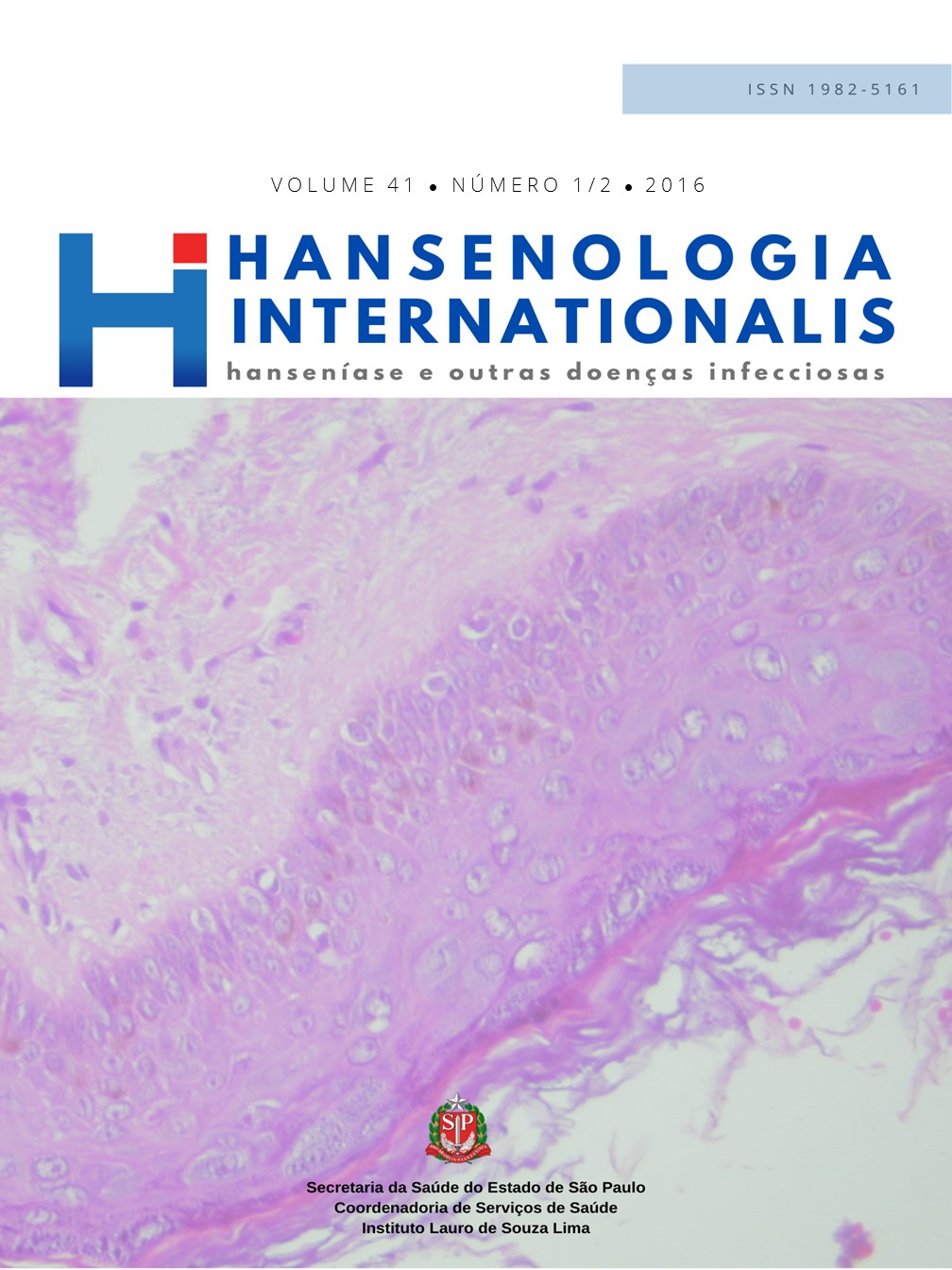Abstract
Introduction: The World Health Organization recommends the degree of disability as an evaluation tool, to propose actions for prevention, monitoring and treatment of physical harm caused by leprosy. Objective: This study aimed to compare the degree of disability at diagnosis, discharge and post-discharge of individuals who have had leprosy. Methods: ecological, analytical study of 126 individuals diagnosed in the period 2004-2013 using: simplified neurological assessment form and classification of the degree of physical disability and form prepared by researcher. In the data analysis. Results: Mean age 56.02 years, and 73.01% multibacillary, with a predominance of form dimorphic (36.80%). It was, in the diagnosis, high percentage (63.49%) of individuals who have had disability (grade 1 and 2).The comparison between diagnosis and postdischarge showed worsening physical, especially in multibacillary, with percentage (51.59%) of leprosy reactions during treatment. Of the total sample, 61 (48.41%) maintained the same level of disability, 44 (34.92%) got worse and 21 (16.67%) improved. Lower limbs were the most affected (58%). Conclusion: The study shows that, when making the comparison in the diagnosis and post-discharge, worsening of disabilities, especially in multibacillary, and the lower limbs segments that have most significant evolution of the degree of disability.
References
2 World Health Organization. Investing to overcome the global impact of neglected tropical diseases [Internet]. Geneva: WHO; 2015. [cited 2016 Mar 12]. Available from: http://apps.who.int/iris/bitstream/handle/10665/152781/9789241564861_eng.pdf;jsessionid=43C55AC41F0833A21B6AA2
5A444805EB?sequence=1.
3 Ministério da Saúde (BR). Vigilância em Saúde: dengue, esquistossomose, hanseníase, malária, tracoma e tuberculose [Internet]. 2a ed. rev. Brasília: Ministério da Saúde; 2008. [cited 2016 Mar 12]. Available from: http://bvsms.saude.gov.br/bvs/publicacoes/cab_n21_vigilancia_
saude_2ed_p1.pdf
4 BRASIL. Ministério da Saúde. Portaria n° 3125, de 7 de outubro de 2010. Aprova as diretrizes para vigilância, atenção e controle da hanseníase. Diário Oficial [da] República Federativa do Brasil, Poder Executivo, Brasília, DF, 15 out. 2010. Seção 1,p. 55. Disponível em: http://pesquisa.in.gov.br/imprensa/jsp/visualiza/index.jsp?jornal=1&pagina=55&data=15/10/2010 . Acesso em: 12 mar.2016.
5 Ministério da Saúde (BR). Secretaria de Vigilância em Saúde. Diretrizes para vigilância, atenção e eliminação da hanseníase como problema de saúde pública [Internet]. Brasília: Ministério da Saúde; 2016. [cited 2016 Mar 12]. Available from: http://www.saude.pr.gov.br/arquivos/File/DiretrizesdoManuaTcnicoOperacionaldeHansenase.pdf
6 Ministério da Saúde (BR). Secretaria de Políticas de Saúde. Guia para o controle de hanseníase [Internet]. Brasília: Ministério da Saúde; 2002. [cited 2016 Mar 12]. Available from: http://bvsms.saude.gov.br/bvs/publicacoes/guia_controle_hanseniase_cab10.pdf.
7 Andrade ARC, Lehman LF, Schreuder PAM, Fuzikawa PL, editores. Como reconhecer e tratar reações hansênícas. 2a ed. Belo Horizonte: Secretaria do Estado da Saúde de Minas Gerais; 2007.
8 Gonçalves SD, Sampaio RF, Antunes CMF. Fatores preditivos de incapacidades em pacientes com hanseníase. Rev Saude Publica. 2009;43(2):267-74. doi: 10.1590/S0034-89102009000200007.
9 Nardi SMT, Cruz LP, Pedro HSP, Marciano LHSC, Paschoal VDA. Avaliação das deficiências físicas em pessoas com hanseníase empregando dois indicadores: grau de incapacidades e Eyes-hands-feet. Hansen Int [Internet]. 2011[cited 2016 Mar 12];36(2):9-15.Available from: http://www.ilsl.br/revista/detalhe_artigo.php?id=11793
10 Ministério da Saúde (BR). Manual de prevenção de incapacidades: cadernos de prevenção e reabilitação em hanseníase, n.1 [Internet]. Brasília: Ministério da Saúde; 2008. [cited 2016 Mar 12]. Available from: http://bvsms.saude.gov.br/bvs/publicacoes/manual_prevencao_incapacidades.pdf
11 Stuart A. A test for homogeneity of the marginal distributions in a two-way classification. Biometrika. 1955;42(3/4):412-6. doi: 10.1093/biomet/42.3-4.412
12 Maxwell AE. Comparing the classification of subjects by two independent judges. Br J Psychiatry. 1970 Jun;116(535):651-5.
13 Johnson RA, Wichern DW. The bonferroni method of multiple comparison. In: Johnson RA, Wichern DW, editors. Applied multivariate statistical analysis. New York: Prentice-Hall; 1992. p.197-9.
14 Pagano M, Gauvreau K. Princípios de bioestatística. São Paulo: Thomson; 2004.
15 Mehta CR, Patel NRA. Network algorithm for performing Fisher’s exact test in rxc contingency tables. J Am Stat Assoc. 1983;78(382):427-34. doi: 10.1080/01621459.1983.10477989.
16 Ministério da Saúde (BR). Indicadores epidemiológicos e operacionais de hanseníase: Brasil 2000-2014 [Internet]. [cited 2016 Mar 12]. Disponível em: http://portalarquivos2.saude.gov.br/images/pdf/2017/julho/10/Percentual-de-grau--de-incapacidade-2-entre-os-casos-novos-avaliados-.pdf
17 Costa LG, Cortela D, Soares RCFR, Ignotti E. Factors associated with the worsening of the disability grade during leprosy treatment in Brazil. Lepr Rev [Internet]. 2015;86(3):265-72. [cited 2016 Mar 12]. Available from: https://www.lepra.org.uk/platforms/lepra/files/lr/Sept15/Lep265-272.pdf.
18 Seshadri D, Khaitan BK, Khanna N, Sagar R. Dehabilitation in the era of elimination and rehabilitation: a study of 100 leprosy patients from a tertiary care hospital in India. Lepr Rev [Internet]. 2015;86(1):62-74. [cited 2016 Mar 12]. Available from: https://www.lepra.org.uk/platforms/lepra/files/lr/Mar15/1850.pdf
19 Mantellini GG, Gonçalves A, Padovani CR. Incapacidades físicas em hanseníase: coisa do passado ou prioridade na prevenção? Hansen Int [Internet]. 2009 [cited 2016 Mar 12];34(2):33-9. Available from: http://www.ilsl.br/revista/detalhe_artigo.php?id=10970
20 Monteiro LD, Alencar CHM, Barbosa JC, Braga KP, Castro MD, Heukelbach J. Incapacidades físicas em pessoas acometidas pela hanseníase no período pós alta da poliquimioterapia em um município no Norte do Brasil. Cad Saúde Pública. 2013;29(5):909-20. doi: 10.1590/S0102--311X2013000500009.
21 Nardi SMT, Ikehara E, Pedro HSP, Paschoal VDA. Characterization of the profession/ occupation
of individuals affected by leprosy and the relationship with limitations in professional activities. Indian J Lepr [Internet]. 2012:84:1-8. [cited 2016 Mar 12]. Available from: http://ijl.org.in/2012/jan-mar/1_Nardi_et_al_(original).pdf
22 Croft RP, Nicholls PG, Richardus JH, Smith WCS. Incidence rates of acute nerve function impairment in leprosy: a prospective cohort analysis after 24 months. Lepr Rev. 2000;71(1):18-33. doi: 10.5935/0305-7518.20000004.
23 Saunderson P, Leekassa R. Reflection on the ILA African Leprosy Congress. Lepr Rev [Internet]. 2005 [cited 2016 Mar 12];76(2):108-11. Available from: https://www.lepra.org.uk/platforms/lepra/files/lr/June05/147353.pdf
24 Leite SCC, Caldeira AP. Oficinas terapêuticas para a reabilitação psíquica de pacientes institucionalizados em decorrência da hanseníase. Cien Saude Colet. 2015;20(6):1835-42. doi: 10.1590/1413-81232015206.16412014.
25 Sousa RRG, Firmino CDB, Sousa MNA, Nascimento MMP. Experiências de um grupo de autocuidado em hanseníase. RIS. 2015 [cited 2016 Mar 12];2(1):136-56. Available from: http://interdisciplinaremsaude.com.br/Volume_3/Trabalho_09.pdf
26 Smith WCS. Review of current research in the prevention of nerve damage in leprosy. Lepr Rev. 2000;71(Supp):S138-44. doi: 10.5935/0305-7518.20000085
This journal is licensed under a Creative Commons Attribution 4.0 International License.
